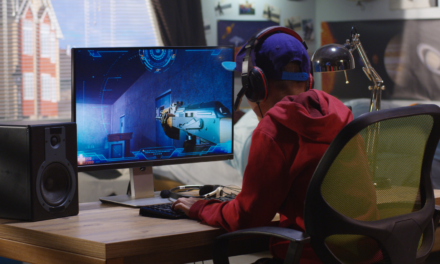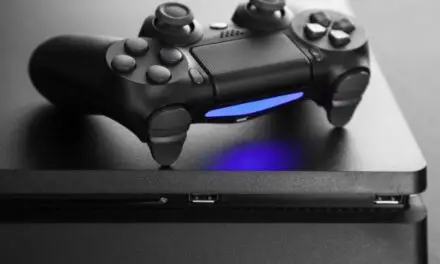You can sit in front of an OLED TV and marvel at the incredible resolution, the deep blacks, and the millions of colors incorporated into one of the best visual technologies in recent times and, all of that tech is only a small part of what makes gaming on an OLED an amazing experience.
There’s no denying the visual appeal. A Sony Playstation 5 or an Xbox Series X will look positively stunning when represented in full OLED glory.
Better yet, a PC can use OLED TVs as a gaming monitor so you can display more graphically intense games.
There are a lot of reasons that make OLED TVS excellent for gaming and we’re about to cover the top 12 on a very long list.
Since we’re on the subject of the visual experience, we may as well start with that one first.
Table of Contents
OLEDs Deliver Superior Image Quality For Gaming

Because older LCD displays use technology that shines light through from the back of the panel to illuminate pixels, it often results in unwanted light bleeding through and washing out the image.
OLEDs do not suffer from this type of light pollution because they can turn on and off each individual pixel and this results in a much more vibrant picture.
The visual quality has little to do with what makes a gaming console run so well on an OLED TV, but it is certainly a marvel of technological achievement.
The graphics that newer generation consoles can push don’t quite match their PC counterparts but nevertheless, are beautifully rendered on OLEDs.
There are several things that elevate the picture quality of an OLED screen well above the rest.
- 100% color fidelity
- Perfect (or very near) blacks
- OLED materials produce their own light
- Best color reproduction
There’s no getting around the fact that OLED technology is incredible compared to comparable models that use different technology.
The organic materials sandwiched within produce their own light and every pixel can operate independently of the rest.
Fast Refresh Rates For A Smooth Gaming Experience
When your monitor displays more frames per second, you get to see visuals that can more easily be missed on displays with lower refresh rates.
This really benefits fast-paced racing or action-type games.
Typically, the refresh rates in OLED TVs are set at 60 or 120Hz. Video games, especially FPS games or something similar, require a fast refresh rate for the smoothest experience possible.
With everything happening on the screen at insane speeds, including texture loading and the thousand other variables in a game, refresh rate is crucial to avoid screen tearing.
Many OLED TVs even include what is called “Variable Refresh Rates,” which adjust with the in-game demand.
No Screen Tearing Or Stuttering Thanks To AMD FreeSync and Nvidia G-Sync
FreeSync and G-Sync are OLED computer monitor technologies that sync the frame rate of the monitor with your graphics processor. With both working in tandem, you never have to worry about screen tearing, since both work in congress at all times.
However, if you’re gaming on an OLED television set, rather than a monitor, it’s not going to include these technologies (Except for some LG models). The above-mentioned variable refresh rate is the OLED TV feature that a gamer wants.
While it doesn’t sync with the GPU in your PC or gaming console, it adjusts at lightning speeds to what your GPU is putting out. It’s not synced, but it’s much better at adjusting refresh rates on the fly.
Fast Response Times
Response time refers to how fast the pixels can change color on your display and this has a major impact on the gaming experience you will have, especially if you’re heavily engaged in a first-person game where the reflexive response is crucial.
A poor response time can lead to issues like ghosting when new frames are appearing on the screen as the old frames are still being displayed.
Response time is where OLEDs really stand out from LCDs.
Because OLED displays can turn on and off each individual pixel like a tiny light bulb, they have much faster response times than LCD displays that use backlighting to illuminate pixels.
In fact, OLEDs can respond as much as 100 times faster than LCDs.
A faster response time makes for a smoother gaming and viewing experience.
A response time of under 5ms is considered acceptable for a gaming monitor.
LG OLED TVs boast a 1ms response time and you’re not going to find anything different when you use an OLED monitor.
Related Article: How Long Do OLED TVs Last? (And How To Extend Their Life)
OLEDs Offer Very Low Input Lag
Input lag refers to the number of milliseconds delay between your mouse, keyboard, or controller and screen.
The lower the input lag, the faster your display will respond to your inputs.
High input lag can lead to a very unresponsive gaming experience and make you feel like your display is playing catch-up with you.
Input lag on all of the LG OLED TVs size 55” to 77” was a consistent 14ms across the board. And the best part is that these were 2019 LG TVs so you’d better believe that the input lag has probably improved over the course of three years.
For example, according to the article, the 2017 input lag was 21ms.
They Provide Great Contrast
With their deep blacks and eye-catching colors, OLEDs offer fantastic contrast ratios and give exceptional high dynamic range (HDR) performance for gaming.
Unlike LCDs, OLEDs have control over every single pixel on the screen.
This means you can have deep black pixels right next to color-popping vibrant pixels for the ultimate in image contrast.
In terms of marketing, you will often hear the term “infinite contrast ratios” bandied about.
Contrast ratios are directly related to the TV’s ability to display High Dynamic Range (HDR).
The contrast is the difference between the brightest white and the darkest black.
OLED TVs achieve their realism by leveraging the power of incredible contrast ratios, which makes them the superior choice for gaming.
OLED Displays Provide High Levels Of Brightness For Gaming In A Brighter Environment
In OLED TVs, every pixel has its own ability to dim or brighten as each one is its own light source, like millions of little, controllable light bulbs. In brightly lit environments, the lights from each pixel can be increased to maximum output.
While this increases your electricity consumption, it also means that you still retain the maximum superior image quality in a bright room that you would normally have in a dark room.
In terms of gaming, that is a feature that is highly desirable, especially when it comes to portable gaming laptops and consoles that come with OLED screens because you never know when you’ll be out in the sun or in a bright room.
Great Viewing Angles
OLED TVs have the widest viewing angles on the market today. For a large gathering, that’s a crucial component, especially on a gaming console where you might find that your turn comes around and you’re standing at the widest area possible from the center of the screen.
An OLED display has a wide viewing angle of about 70 degrees from the center.
That means you can wheel off to the side of your OLED monitor in your gaming chair and still have a clear image with good color contrast.
If you tried that with an LCD display, the image would end up looking completely washed out.
OLEDs Provide A Broad Range Of Colors To Make Gaming More Immersive
One of the major features of OLED TVs is the realism in the display, thanks to superior contrast capabilities.
The colors on an OLED are individual because each pixel is its own light source.
That gives an OLED display a great range for every color in the spectrum. It provides fantastically deep blacks and brilliantly bright, peak whites and improved color accuracy to give a sense of realism and an overall level of immersion when gaming.
OLEDs Don’t Consume Much Power
Any hardcore gamer will tell you that any game can run into hours at a time, depending on what’s going on. Casual gamers aren’t going to worry about power consumption as much, since they spend less time in front of the monitor.
However, since each pixel can reduce or turn off its light when necessary, OLEDs save power in the long term. Other TV lights remain on, while OLED lights turn completely off for the deepest blacks and remain off until they’re needed.
Because of that, OLEDs consume an average of 40% to 80% less power than an LCD TV.
The drawback is that if you are playing a very bright game and all of the pixels are lit up bright, an OLED can consume more than 300% of the power that an LCD does.
They Can Tolerate A Broad Range Of Temperatures
Heat is the enemy of gamers the world over.
Especially when running a game at max settings.
While it may be questionable for their computer, an OLED TV can handle the temperature just fine.
In fact, OLEDs have a broader operable temperature range than any other TV technology, so you can game for hours without worrying if things are getting too hot for your screen.
OLEDs Are Light And Thin With Small Bezels
Because of the technology that goes into an OLED TV, it doesn’t require a giant amount of space.
OLED TVs and monitors are generally very slim, with smaller bezels.
Of course, this is pretty advantageous in that you can easily wall-hang it without tearing out the wall under the weight.
It’s also great for portable gaming because the screen takes up less space and less space for screen requirements means more room for everything else.



